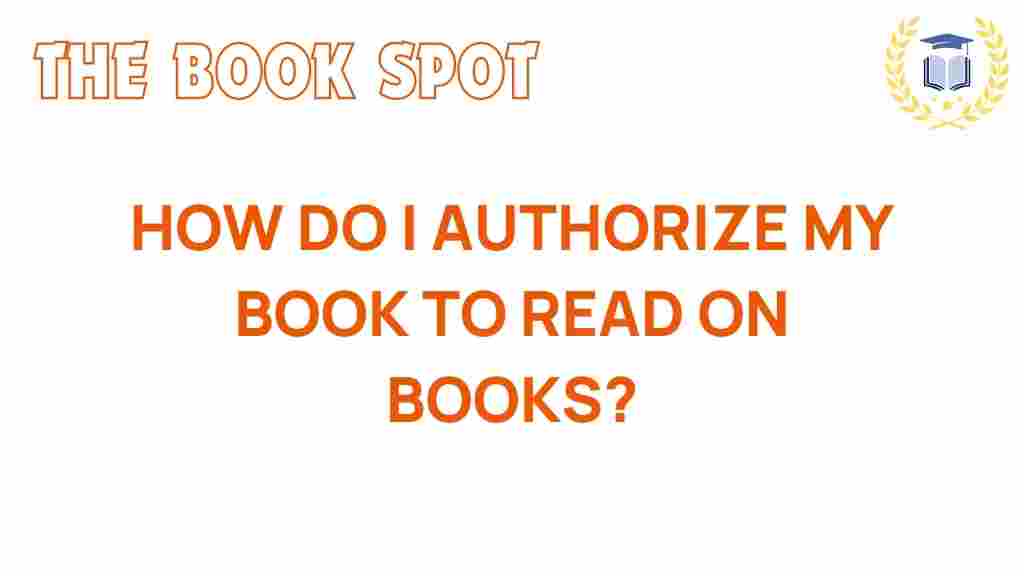Unlocking Access: How to Authorize Your Book for Reading
In the ever-evolving world of digital publishing, authors face numerous challenges when it comes to managing their books, from ensuring reader access to navigating the complexities of online libraries. If you’re an author looking to authorize your book for reading, you’re in the right place. This comprehensive guide will help you understand the process of granting reading access to your e-books, offering valuable publishing tips along the way.
Understanding the Importance of Reader Permissions
Before diving into the steps to authorize your book, it’s essential to grasp why reader permissions matter. Properly managing access to your book not only protects your intellectual property but also enhances the reader experience. Ensuring that your audience can easily access your content while safeguarding against unauthorized distribution is crucial in today’s digital landscape.
Step-by-Step Process to Authorize Your Book
Follow these steps to effectively authorize your book for reading:
Step 1: Choose Your Publishing Platform
The first step in the authorization process is selecting the right digital publishing platform. Popular options include:
- Amazon Kindle Direct Publishing (KDP)
- Smashwords
- Kobo Writing Life
- Draft2Digital
Each platform has its own guidelines for book management and access settings, so choose one that aligns with your goals.
Step 2: Upload Your Manuscript
Once you’ve chosen a platform, the next step is to upload your manuscript. Ensure that your e-book file is formatted correctly for the platform. Common formats include:
Most platforms provide detailed instructions for formatting, which can significantly ease the upload process.
Step 3: Set Reader Permissions
After uploading your manuscript, it’s time to set the reading access permissions. This is where you can determine who can read your book and under what conditions. Consider the following options:
- Public Access: Anyone can read your book.
- Restricted Access: Only specific users can access your book.
- Password Protection: Readers must enter a password to access your book.
Setting the right permissions is crucial for both protecting your work and ensuring that your intended audience can access it.
Step 4: Publish Your Book
Once you have configured the permissions, you can proceed to publish your book. Make sure to double-check all settings before hitting the publish button. This is a critical step in ensuring your book reaches your audience with the correct access.
Step 5: Promote Your Book
After publishing, it’s time to promote your e-book. Utilize social media, author websites, and online libraries to reach potential readers. Consider the following promotional strategies:
- Share excerpts on social media platforms.
- Engage with readers through virtual book readings.
- Join online book clubs and forums to discuss your work.
Effective promotion can significantly enhance your book’s visibility and sales.
Troubleshooting Common Issues
Even with a solid plan, you might encounter issues while authorizing your book for reading. Here are some common problems and solutions:
Issue 1: Readers Can’t Access the Book
If readers report that they cannot access your book, check the following:
- Ensure that the book is published and not in draft mode.
- Verify that reader permissions are correctly set.
- Check for any regional restrictions imposed by the platform.
Issue 2: Formatting Problems
Sometimes, readers might experience formatting issues. To resolve this:
- Review the formatting guidelines provided by your publishing platform.
- Consider using professional formatting services to refine your e-book.
Issue 3: Technical Glitches
If you encounter technical issues, such as uploading errors or permission settings not saving, try the following:
- Clear your browser cache and try again.
- Use a different browser or device.
- Contact the platform’s customer support for assistance.
Conclusion
Authorizing your book for reading is a vital step in the digital publishing process. By following the steps outlined in this guide, you can ensure that your e-books are accessible to your target audience while protecting your intellectual property. Remember that effective book management involves not only setting permissions but also actively promoting your work to maximize its reach.
For more information on digital publishing, check out this comprehensive guide on self-publishing. With the right strategies in place, you’ll be well on your way to successfully authorizing your book and connecting with readers worldwide.
Happy publishing!
This article is in the category Guides and created by TheBookSpot Team
